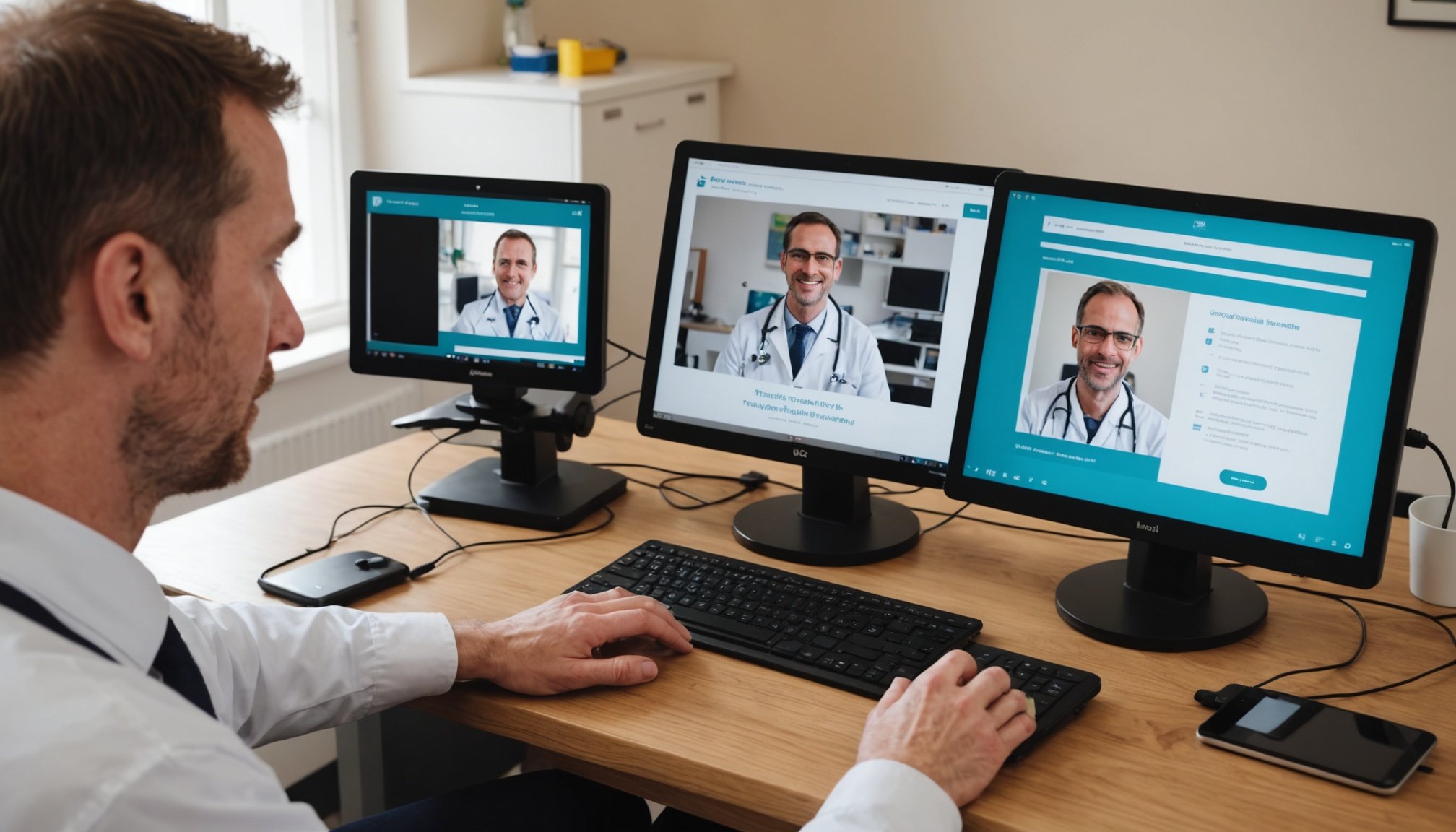Unlocking Rural UK Healthcare with Telemedicine: Revolutionizing Access and Efficiency
The Need for Telemedicine in Rural UK
Rural communities in the UK face significant challenges when it comes to accessing quality healthcare. The scarcity of medical facilities, long travel times, and a shortage of healthcare professionals are just a few of the hurdles that these communities must overcome. Telemedicine, the use of digital communication tools to provide clinical services remotely, has emerged as a transformative solution to these problems.
Telemedicine addresses the disparities in healthcare access by bringing medical services directly to the patients’ homes or local community health centers. For instance, in rural areas where specialist care is often unavailable, telemedicine connects patients with specialists from across the country. This not only improves access to care but also reduces the need for lengthy and often costly travels to urban healthcare facilities[1][2][3].
In parallel : Revolutionizing oil company operations with vallourec solutions
Benefits of Telemedicine for Rural Healthcare
Telemedicine offers a multitude of benefits that are particularly pertinent for rural healthcare.
Enhanced Accessibility
One of the most significant advantages of telemedicine is its ability to enhance accessibility to healthcare services. Through video consultations, remote monitoring, and electronic prescriptions, patients can receive medical care without the need for physical visits. This is especially beneficial for those with chronic conditions who require regular check-ups. For example, the NHS’s telehealth initiative for chronic disease management has significantly reduced hospital admissions by enabling remote monitoring and virtual consultations for patients with conditions like diabetes and heart disease[1][2][4].
Also read : Engage & Captivate: Cutting-Edge Podcast Techniques for UK Museum Visitors
Convenience and Cost-Effectiveness
Telemedicine is not only convenient but also cost-effective. It reduces the need for hospital admissions and emergency room visits, which can be costly and logistically challenging for rural patients. A study found that telehealth services led to a 30% reduction in emergency room visits and a 20% decrease in hospital admissions. This not only saves costs but also reduces the time patients spend away from work or personal commitments[1][2].
Improved Patient Outcomes
Telemedicine facilitates timely medical interventions, which are crucial for improving patient outcomes. Remote monitoring allows healthcare providers to keep a close eye on patients with chronic diseases, enabling early intervention and better health outcomes. Here are some key ways telemedicine improves patient outcomes:
- Early Intervention: Remote monitoring helps in identifying early symptoms of chronic conditions, allowing for prompt medical intervention.
- Continuous Care: Telemedicine enables continuous monitoring and follow-up care, which is essential for managing conditions like diabetes, hypertension, and cardiovascular diseases.
- Reduced Hospitalizations: By managing chronic conditions effectively, telemedicine reduces the need for hospital admissions, thereby improving overall health outcomes[1][2][3].
Successful Implementation Strategies
The successful implementation of telemedicine in rural areas requires several strategic steps.
Clear Guidelines and Standards
Establishing clear guidelines and standards for telemedicine practice is vital. The General Medical Council (GMC) provides guidance on the ethical and legal obligations of doctors engaging in telemedicine, ensuring that the quality of care is equivalent to in-person consultations. Compliance with the Care Quality Commission (CQC) standards is also mandatory to ensure the safety and quality of healthcare services[1].
Integration with Existing Healthcare Systems
Seamless integration with existing healthcare systems is crucial. This involves aligning new telehealth platforms with current infrastructure to avoid disruptions in service delivery. For example, Access TeleCare has successfully integrated telemedicine programs across all 50 states in the U.S., providing virtual specialty care that is accessible to a significant portion of the population. This model can be replicated in the UK to ensure comprehensive coverage[1].
Training and Education
Training and education are central to mastering telemedicine tools. Healthcare providers should undergo regular training sessions that cover the latest technologies and protocols. These sessions should also emphasize the importance of digital empathy and effective online communication to build trust with patients. Here are some key training areas:
- Technology Familiarization: Providers need to be comfortable using telemedicine platforms and tools.
- Digital Communication Skills: Effective online communication is crucial for building patient trust and ensuring clear understanding.
- Data Security: Ensuring patient data security is a top priority, and providers must be trained on best practices for data protection[2].
Case Studies and Statistics
Several case studies and statistics highlight the effectiveness of telemedicine in enhancing rural healthcare access.
NHS Telehealth Initiative
The NHS’s telehealth initiative for chronic disease management is a notable example. By utilizing remote monitoring and virtual consultations, patients with conditions like diabetes and heart disease have experienced improved health outcomes. This initiative has significantly reduced hospital admissions, demonstrating the potential of telemedicine to alleviate the strain on healthcare facilities while enhancing patient care[1].
Access TeleCare
Access TeleCare, a leading provider of acute specialty telemedicine in the U.S., has implemented over 2,300 telemedicine programs across all 50 states. Their services have reduced patient transfers by up to 40% and increased ICU average daily census by 30% in some hospitals. This model can be adapted in the UK to improve rural healthcare access and efficiency[1].
Overcoming Challenges
While telemedicine offers numerous benefits, it also comes with its own set of challenges.
Broadband Internet Access
One of the significant challenges is the requirement of broadband internet for many telemedicine functionalities. Rural areas often have limited access to broadband internet, which can hinder the utilization of telehealth services. Addressing this issue involves targeted interventions to expand broadband infrastructure in these areas. For instance, policies focusing on expanding residency programs in rural hospitals and supporting the integration of telehealth into existing healthcare infrastructure can help bridge this gap[3].
Technological Limitations
Technological limitations and data security concerns are other challenges that need to be addressed. Investing in reliable technology infrastructure and conducting comprehensive staff training can help overcome these challenges. Here are some strategies to mitigate these issues:
- Investing in Infrastructure: Ensuring that the technology used is reliable and secure.
- Staff Training: Regular training sessions to keep healthcare providers updated on the latest technologies and security protocols.
- Patient Education: Educating patients on the benefits and safe use of telemedicine services[1][2].
Actionable Insights for Healthcare Providers
Implementing telemedicine best practices is crucial for healthcare providers aiming to enhance patient care and accessibility.
Provider Guidelines
Establishing provider guidelines that ensure consistency and quality across digital consultations is vital. This involves selecting appropriate platforms, safeguarding patient data, and maintaining clear communication channels.
Rural Healthcare Strategies
Engaging rural communities in telemedicine services requires innovative strategies. Here are some actionable insights:
- Local Community Centers: Leveraging local community centers or mobile units to offer telemedicine access, ensuring those without personal internet or devices can still utilize these services.
- Educational Campaigns: Conducting educational campaigns about the benefits of telemedicine to encourage participation among rural populations and address potential technological hesitations[2].
The Future of Telemedicine in Rural UK
As the UK continues to embrace telemedicine, it is clear that this innovative approach will play a critical role in improving healthcare access and outcomes for rural communities.
Digital Transformation in Healthcare
Telemedicine is a cornerstone of digital transformation in healthcare, especially in increasing access to healthcare for remote or underserved populations. Virtual consultations allow patients to receive medical advice, diagnoses, and prescriptions without needing to travel. This digital transformation also enables better data-driven decision making through digitized health records and advanced analytics tools[4].
Role of Artificial Intelligence
Artificial intelligence (AI) is also set to play a significant role in enhancing telemedicine services. AI can help in analyzing patient data to identify trends, predict outcomes, and allocate resources more effectively. For example, AI-powered remote monitoring systems can alert healthcare providers to any changes in a patient’s condition, enabling timely interventions[4].
Telemedicine is not just a solution but a necessity for enhancing rural healthcare access in the UK. By understanding its benefits, addressing its challenges, and implementing it effectively, we can create a more resilient and equitable healthcare system that serves all communities, regardless of their geographical location.
Here is a summary of the key points in a detailed bullet point list:
- Enhanced Accessibility: Telemedicine improves access to healthcare services, especially for those in rural areas.
- Convenience and Cost-Effectiveness: Reduces the need for hospital admissions and emergency room visits, saving time and money.
- Improved Patient Outcomes: Facilitates timely medical interventions and continuous monitoring of chronic conditions.
- Clear Guidelines and Standards: Ensuring quality and safety through compliance with GMC and CQC standards.
- Integration with Existing Systems: Aligning new telehealth platforms with current infrastructure.
- Training and Education: Regular training sessions for healthcare providers on technology and digital communication.
- Overcoming Challenges: Addressing broadband internet access and technological limitations through targeted interventions.
- Actionable Insights: Implementing provider guidelines, leveraging local community centers, and conducting educational campaigns.
- Future of Telemedicine: Embracing digital transformation and the role of AI in enhancing telemedicine services.
Table: Comparison of Telemedicine Benefits in Rural vs. Urban Areas
| Benefit | Rural Areas | Urban Areas |
|---|---|---|
| Access to Specialists | Critical due to scarcity of specialists in rural areas | Easier access to specialists due to higher concentration of medical facilities |
| Travel Time | Significantly reduces travel time and associated costs | Less impact on travel time as facilities are generally closer |
| Cost-Effectiveness | Reduces hospital admissions and emergency room visits, saving costs | Similar cost savings but less pronounced due to existing infrastructure |
| Patient Engagement | Encourages active patient engagement through remote consultations | Similar engagement benefits but with more options for in-person care |
| Remote Monitoring | Crucial for managing chronic conditions in areas with limited healthcare access | Useful but less critical due to availability of in-person care options |
| Data Security | Same importance as in urban areas, with a focus on ensuring secure remote access | Same importance as in rural areas, with a focus on ensuring secure remote access |
Quotes from Experts
- “Telemedicine is a game-changer for rural healthcare in the UK, offering enhanced accessibility, convenience, and cost-effectiveness.” – [ReadyForServices][1]
- “The introduction and expansion of telemedicine in rural regions hold significant promise for addressing healthcare disparities.” – [Decimal Time][2]
- “Telemedicine serves as a potentially promising solution to overcome the inadequacies of physical health facilities in rural areas.” – [MedRxiv][3]
By embracing telemedicine and addressing its challenges, the UK can ensure that everyone, regardless of their geographical location, has access to high-quality healthcare. As we move forward, it is essential to continue innovating and improving telemedicine services to meet the evolving needs of rural populations.











